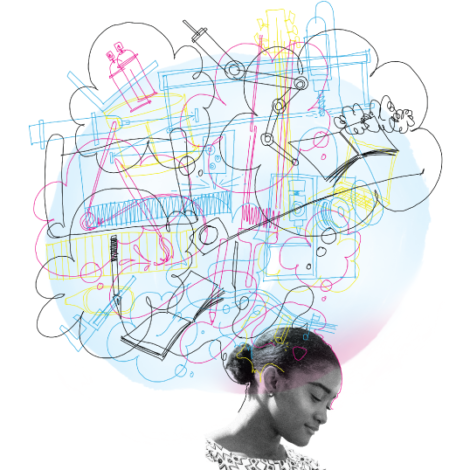Defining Basic Terms: “The Arts” and “Integration”

What is arts integration? In interviews with over 300 faculty and administrators from research universities, a2ru researchers discovered that language—specifically, a lack of shared definitions for key concepts– presents one of the most striking obstacles to the interdisciplinary and inter-professional work of arts integration and collaborative practice. In response, our research seeks to clarify common sources of ambiguity and build shared understanding. The results provide accessible, reusable resources for communications around programs, research, and curricula.
What do we mean by “The Arts?”
Here at a2ru, when we talk about the arts we are referring to the mindsets and practices of creativity and making—strongly associated with the humanities and the fine, performing, and applied arts & design—rather than the discipline labels themselves.
What do we mean by “Integration?”
Integration can mean different things to different people, and arts integration is no exception. Practitioners take both formal and informal approaches—from thinking in terms of interdisciplinary and transdisciplinary archetypes, to simply showing up and working together. Successful integration actually involves two complementary activities:
Differentiation: recognizing the distinctions between fields, perspectives, practices and possibilities.
&
Integration: recognizing the meaningful applications and connections
between fields, perspectives, practices and possibilities—as well as
their contingencies.

Read a free excerpt from our book The Case for Arts Integration with examples of arts integration in practice at universities across the country.
The full text of the book is a member-only resource.
Learn More
Our definition of integration draws from work on Integrative Complexity in cognition, decision making, and social psychology:
Suedfeld, P., & Rank, A. D. (1976). Revolutionary leaders: Long-term success as a function of changes in conceptual complexity. Journal of Personality and Social Psychology, 34, 169-178.
Suedfeld, P., Tetlock, P.E., & Streufert, S. (1992). Conceptual/integrative complexity. In C. P. Smith (Ed.), Motivation and personality: Handbook of thematic content analysis (pp. 393-400). Cambridge, UK: Cambridge University Press.
Feist, G. J. (1994). Personality and working style predictors of integrative complexity: A study of scientists’ thinking about research and teaching. Journal of Personality and Social Psychology, 67(3), 474.
Suedfeld, P., & Tetlock, P. E. (2001). Individual differences in information processing. Blackwell handbook of social psychology: Intra-individual processes, (pp. 284-304).
Complementary definitions for integration may also be found in:
Barber, J. P. (2012). Integration of learning: A grounded theory analysis of college students’ learning. American Educational Research Journal, 49(3), 590-617. (Education)
Barry, A., Born, G., and G. Weszkalnys (2008) Logics of Interdisciplinarity. Economy and Society, 37(1): 20-49. [Anthropology]
Burt, R. S. (2004). Structural holes and good ideas. American Journal of Sociology, 110(2), 349-399. (Sociology)
Ludwig, D. (2016). Overlapping ontologies and Indigenous knowledge. From integration to ontological self-determination. Studies in History and Philosophy of Science Part A, 59, 36-45. (Anthropology and Philosophy)
Mansilla, V. B., Duraisingh, E. D., Wolfe, C. R., & Haynes, C. (2009). Targeted assessment rubric: An empirically grounded rubric for interdisciplinary writing. The Journal of Higher Education, 80(3), 334-353. (Interdisciplinary Studies)
Julia Marshall (2010) Five Ways to Integrate: Using Strategies from Contemporary Art, Art Education, 63:3, 13-19. (Art Education)
O’Rourke, M., Crowley, S., & Gonnerman, C. (2016). On the nature of cross-disciplinary integration: A philosophical framework. Studies in History and Philosophy of Science Part C: Studies in History and Philosophy of Biological and Biomedical Sciences, 56, 62–70. (Philosophy of Science)
Pohl, C., van Kerkhoff, L., Hirsch Hadorn, G., and Bammer, G. (2008). Integration in G. Hirsch Hadorn et al. (eds.), Handbook of Transdisciplinary Research. Springer. (Interdisciplinary Studies)
Repko, A. (2007). Integrating interdisciplinarity: How the theories of common ground and cognitive interdisciplinarity are informing the debate on interdisciplinary integration. Issues in Interdisciplinary Studies. 25, 1-31. (Interdisciplinary Studies)
Rhoten, D., & Pfirman, S. (2007). Women in interdisciplinary science: Exploring preferences and consequences. Research Policy, 36(1), 56-75. (Interdisciplinary Studies)
Conway III, L. G., Suedfeld, P., & Tetlock, P. E. (2018). Integrative complexity in politics. In The Oxford Handbook of Behavioral Political Science. Oxford, UK: Oxford University Press.
